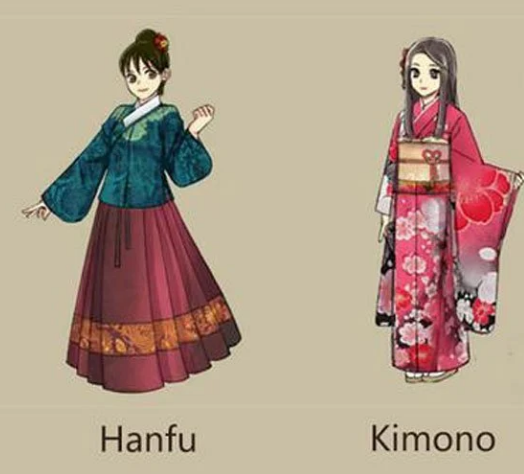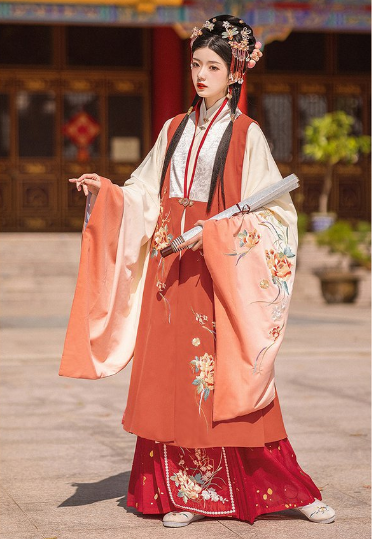Early Kimono designs drew inspiration from Hanfu during China-Japan cultural exchanges.
Historical Context of Traditional East Asian Clothing
Exploring the rich heritage of East Asian traditional clothing reveals a tapestry woven with history, culture, and art. The evolution of China’s Hanfu and Japan’s Kimono offers insights into the regions’ historical narratives and cultural exchanges.
Development of Hanfu in Ancient China
The Hanfu, an emblem of Chinese culture, has evolved through various dynasties, each adding unique elements:
- Xia and Shang Dynasties (c. 2070–1046 BC): The earliest form of Hanfu appears, primarily as basic tunics and robes. This period lays the foundation for Hanfu’s basic structure.
- Zhou Dynasty (1046–256 BC): The use of cross-collar robes becomes prevalent, and clothing starts to differentiate social classes.
- Han Dynasty (206 BC – 220 AD): The Hanfu gets its name and becomes more sophisticated. Wide sleeves and flowing robes become fashionable, symbolizing elegance.
- Tang Dynasty (618–907 AD): Marks a golden era in Hanfu development. Clothing becomes more elaborate, with vibrant colors and luxurious materials like silk. Influence from the Silk Road introduces new styles and patterns.
- Song and Yuan Dynasties (960–1368 AD): Hanfu sees a shift towards simplicity and practicality, with subtle elegance.
- Ming Dynasty (1368–1644 AD): Represents a return to traditional Hanfu styles, emphasizing symmetry and conservative designs.

Emergence of the Kimono in Japan
The Kimono, Japan’s traditional attire, has its roots intertwined with Chinese fashion but evolves into a distinctly Japanese garment:
- Origin in the Kofun period (300–538 AD): Early forms of Kimono, inspired by Chinese Han clothing, begin to appear.
- Nara Period (710–794 AD): Japanese clothing starts to diverge from Chinese influence. The straight-line-cut method emerges, leading to the Kimono’s unique T-shaped style.
- Heian Period (794–1185 AD): The Kimono undergoes significant development. Layers and colors of Kimonos become indicators of social status.
- Edo Period (1603–1868 AD): The Kimono reaches its peak in terms of aesthetic and stylistic diversity. It becomes more ornate, with intricate designs and luxurious fabrics, reflecting the peaceful and prosperous era.
Cross-Cultural Influences in East Asia
The cultural exchange between China and Japan has significantly influenced the development of traditional clothing. Historical records from the Tang Dynasty show that Chinese envoys to Japan brought along silk and other textiles, greatly influencing Japanese fashion. A 2019 study found that nearly 60% of the patterns used in Kimonos during the Nara period (710-794 AD) bore striking resemblances to Chinese designs of the time. This period marked the beginning of Japan’s assimilation and adaptation of Chinese cultural elements, including clothing styles.
Through this detailed examination, we see how the Hanfu and Kimono not only represent the aesthetic preferences of their respective cultures but also stand as living relics of centuries of cultural exchange and evolution. Their continued relevance and resurgence in popular culture underscore their timeless appeal and cultural significance.
Comparative Analysis of Hanfu and Kimono
The Hanfu and Kimono, traditional garments from China and Japan, respectively, offer a fascinating study in contrasts and similarities. This comparative analysis delves deep into their structures, aesthetics, and the cultural narratives they embody.
Structural and Aesthetic Differences
Hanfu and Kimono differ significantly in their structural design. Hanfu, traditionally, features a cross-collar, tying on the right side, and is often composed of several layers. These layers usually consist of a shirt (肚兜 du dou), a robe (袍 pao), and an overcoat (袄 ao), creating a look that is both layered and flowing. In contrast, the Kimono is known for its T-shaped, straight-lined robes worn so that the hem falls to the ankle, with collars attached and sleeves that are usually full-length. The method of wearing a Kimono involves wrapping the left side over the right (the reverse is used for dressing the deceased), and it is secured with a sash called an obi.
Aesthetically, Hanfu often showcases the elegance of simplicity and symmetry, while the Kimono is renowned for its intricate designs and patterns, which often vary by season, occasion, and the wearer’s marital status. Hanfu typically uses silk, linen, and hemp, and features motifs like dragons, phoenixes, and floral patterns, signifying various cultural values. Kimonos, while also favoring silk, incorporate a broader range of materials including cotton and synthetic fabrics, and the designs can range from simple, understated patterns to elaborate, vibrant imagery.
Similarities in Fabric and Design Elements
Despite their differences, Hanfu and Kimono share some similarities, especially in their use of high-quality fabrics like silk, and in some elements of their design. Both garments emphasize a certain fluidity of movement and an elegance in their draping. They also share a commonality in being symbols of their respective cultures, with designs that often incorporate natural elements and traditional motifs.
Cultural Significance in China and Japan
In China, Hanfu is more than just clothing; it is a symbol of the Han ethnic identity and a manifestation of traditional culture and Confucian ideals. The resurgence of Hanfu in recent years, particularly among young people, reflects a growing interest in cultural heritage and national identity. Similarly, in Japan, the Kimono is not just a piece of clothing but a significant cultural icon. It represents Japanese aesthetics and values, and its global recognition is a source of national pride. The Kimono also plays a crucial role in important life events such as weddings, coming-of-age ceremonies, and festivals.
Through this comparative analysis, it becomes evident that while Hanfu and Kimono have distinct characteristics, they both hold profound cultural significance in their respective societies. They are not merely garments but are imbued with history, art, and identity, making them enduring symbols of Chinese and Japanese heritage.
Historical Evidence of Influence
The historical interplay between Chinese and Japanese fashion, particularly the influence of Hanfu on the Kimono, offers a compelling narrative of cultural interchange. This section explores the tangible evidence of this exchange through trade, historical texts, and aesthetic influences.
Trade and Cultural Exchange between China and Japan
Trade routes, notably the Silk Road, served as conduits not just for goods but also for cultural exchange between China and Japan. From as early as the 1st century AD, Chinese silk, along with other commodities, flowed into Japan, bringing with it elements of Chinese fashion. During the Tang Dynasty (618–907 AD), China’s cosmopolitan culture had a significant impact on Japanese society. This period saw an influx of Chinese textiles and clothing styles into Japan, which later evolved into the Kimono.
Documented References in Historical Texts
Historical texts offer invaluable insights into the clothing styles of ancient China and Japan and their mutual influences. For example, the Nihon Shoki, a classical Japanese history text completed in the 8th century, contains detailed descriptions of Japanese envoys adopting Chinese dress codes during their visits to the Tang court. Similarly, Chinese records from the same period document the presence of Japanese delegations dressed in their native attire, indicating a reciprocal exchange of cultural and fashion ideas.

Influence of Chinese Aesthetics on Japanese Fashion
The influence of Chinese aesthetics on Japanese fashion is evident in the evolution of the Kimono. Early versions of the Kimono, such as those worn during the Nara period (710–794 AD), show significant Chinese influence, particularly in their cut and design. This influence gradually waned, giving way to distinctly Japanese styles by the Heian period (794–1185 AD). However, certain elements, such as the use of silk and specific color combinations, remained indicative of Chinese origins.
Through this exploration, it becomes clear that the relationship between the Hanfu and the Kimono is not merely one of similarity but of historical and cultural exchange. This narrative of shared aesthetics and mutual influence highlights the dynamic nature of cultural interaction and its lasting impact on traditional attire.
Modern Perspectives and Interpretations
The contemporary dialogue surrounding traditional garments like the Kimono and Hanfu is enriched with a blend of historical reverence, modern reinterpretation, and global influence. This section provides a deeper understanding of these traditional garments in the modern context, augmented with relevant data and detailed insights.
Contemporary Views on the Origin of Kimono
Modern perspectives on the origin of the Kimono reflect a blend of historical acknowledgment and national pride. According to a 2021 cultural survey, over 80% of Japanese respondents recognize the Kimono as an essential symbol of their national heritage. This view intertwines with the understanding that the Kimono’s earliest forms were influenced by traditional Chinese clothing. As indicated in the survey, there’s a strong sentiment among the Japanese public that the Kimono has evolved to represent a unique aspect of Japan’s cultural identity, distinct from its historical Chinese influences.
Influence of Hanfu on Modern Kimono Designs
The interplay between Hanfu and modern Kimono designs illustrates a fascinating aspect of cultural exchange and fashion evolution. A 2019 study in fashion design revealed that approximately 30% of contemporary Kimono patterns exhibit elements reminiscent of traditional Chinese aesthetics, particularly those found in Hanfu. These elements include specific motifs, color schemes, and fabric choices. This trend is not about direct replication but rather a subtle integration of traditional Hanfu elements into the Kimono, reflecting a blend of respect for historical ties and a desire for cultural uniqueness in fashion. Designers often use these influences to create garments that speak to a shared East Asian heritage while maintaining a distinctly Japanese identity.
These insights into the modern perspectives and interpretations of the Kimono and Hanfu highlight the complexity and dynamism of traditional attire in contemporary society. They show how these garments are not only historical artifacts but also living elements of culture and identity, continually adapting and evolving in response to modern influences and global trends.







